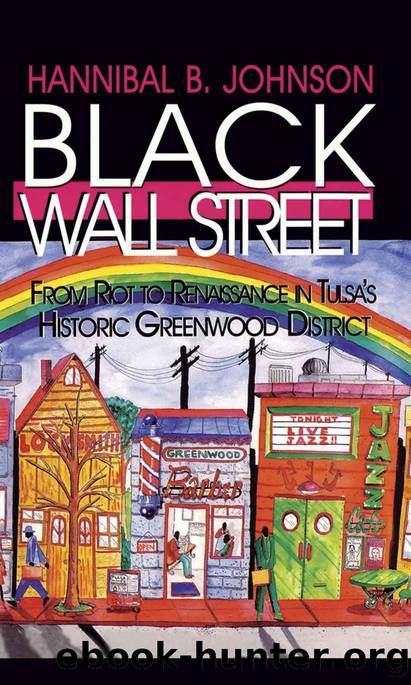Black Wall Street: From Riot to Renaissance in Tulsa's Historic Greenwood District by Hannibal B. Johnson

Author:Hannibal B. Johnson [Johnson, Hannibal B.]
Language: eng
Format: epub
ISBN: 9781940130262
Publisher: Eakin Press
Published: 2014-03-01T07:00:00+00:00
1990 OKLAHOMA JAZZ HALL OF FAME INDUCTEES
THE BLUE DEVILS
The Blue Devils are perhaps Oklahoma’s most famous jazz band. Having roots in Oklahoma City in the early 1920s, they went on to become nationally acclaimed, influencing scores of musicians along the way. Count Basie said that the first time he heard the Blue Devils “was probably the most important turning point in my musical career—once a Blue Devil, always a Blue Devil.” The Blue Devils produced such great artists as Walter Page, Oran “Hot Lips” Page, James Rushing, Eddie Durham, Buster Smith, Lester Young, Abe Bolar, and Alvin Burroughs. They recorded only one session. That was November of 1929. The personnel from that band became the nucleus of the Bennie Moten band in the early 1930s, which later formed the core of the Count Basie Band.
Part of the reason for their vast influence came from the new verve that they brought to jazz through their many innovations. Walter Page brought the string bass into prominence in big bands. James Rushing permanently changed the big band vocal style. Buster Smith became the prominent influence on a cadre of musicians in the midand late-thirties, including the young Charlie Parker. Many people credit the Blue Devils with beginning the “riff ” structure which has become one of the hallmarks of jazz. With these innovations and the abundance of talented soloists, the Blue Devils have become legendary among the “territorial bands.”
AL DENNIE
Al Dennie was born near Arcadia, Oklahoma, on September 27, 1903. He was one of many great musicians introduced to music by Douglass High School teacher Zelia Breaux. Dennie moved to Kansas City and received further training from a Tuskegee graduate, Professor Dawson. His professional beginnings go back to his days with such seminal Kansas City bands as Chauncie Downs and the Rinky Dinks, George Wilkerson’s Musical Magnets, Jessie Stone’s band, and Bennie Moten’s band.
Along with Bennie Moten, he organized the Jap Allen Band. This group toured extensively throughout the Midwest, soon becoming featured in many of the historic band battles which were such an important part of Kansas City’s daily musical menu. He also played a prominent role in the Paul Banks Orchestra, another important early territorial band.
Dennie was one of the first people to notice the developing talent of a seventeen-year-old piano player named Jay McShann. Jay’s first lessons in big band music were taken from Al Dennie in Tulsa. Dennie spent much of his life in Kansas City, playing and keeping company with jazz legends from Kansas City and all across the country.
CLARENCE LOVE
Clarence Love was born on January 25, 1908, in Muskogee, Oklahoma. His family moved to Kansas City, where he first began his music studies. His first influence was Charlie Watts, a protege of ragtime genius Scott Joplin. He attended Kansas City’s Lincoln High School, forming a jazz band there before he graduated. He was inspired to become a full-time professional musician after hearing George Lee’s Band performing at Kansas City’s Lyric Hall. By 1928, he had formed the Clarence Love Orchestra which included some of Kansas City’s finest musicians.
Download
This site does not store any files on its server. We only index and link to content provided by other sites. Please contact the content providers to delete copyright contents if any and email us, we'll remove relevant links or contents immediately.
| African-American Studies | Asian American Studies |
| Disabled | Ethnic Studies |
| Hispanic American Studies | LGBT |
| Minority Studies | Native American Studies |
Cecilia; Or, Memoirs of an Heiress — Volume 1 by Fanny Burney(31333)
Cecilia; Or, Memoirs of an Heiress — Volume 3 by Fanny Burney(30934)
Cecilia; Or, Memoirs of an Heiress — Volume 2 by Fanny Burney(30889)
The Great Music City by Andrea Baker(21318)
We're Going to Need More Wine by Gabrielle Union(18074)
Bombshells: Glamour Girls of a Lifetime by Sullivan Steve(13109)
Pimp by Iceberg Slim(12932)
All the Missing Girls by Megan Miranda(12752)
Fifty Shades Freed by E L James(12451)
Norse Mythology by Gaiman Neil(11883)
Talking to Strangers by Malcolm Gladwell(11879)
Crazy Rich Asians by Kevin Kwan(8351)
Mindhunter: Inside the FBI's Elite Serial Crime Unit by John E. Douglas & Mark Olshaker(7834)
The Lost Art of Listening by Michael P. Nichols(6474)
Enlightenment Now: The Case for Reason, Science, Humanism, and Progress by Steven Pinker(6406)
Bad Blood by John Carreyrou(5770)
The Four Agreements by Don Miguel Ruiz(5511)
Weapons of Math Destruction by Cathy O'Neil(5038)
We Need to Talk by Celeste Headlee(4870)
